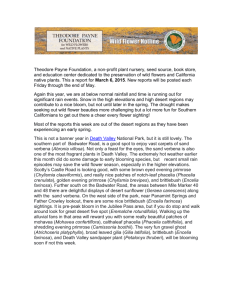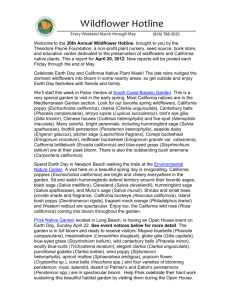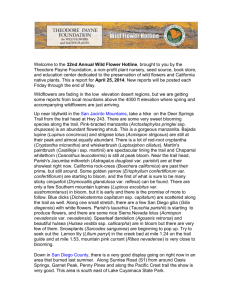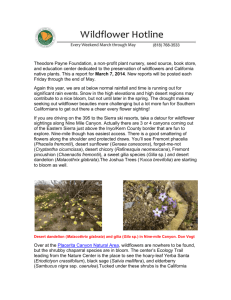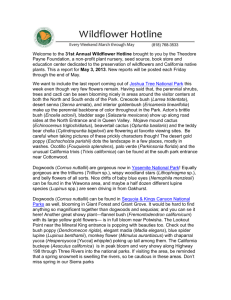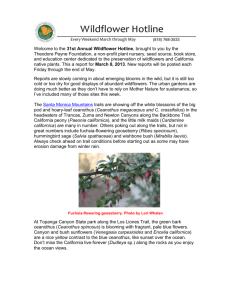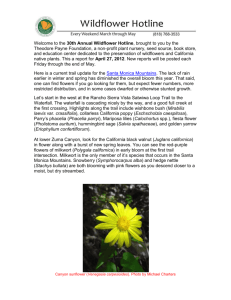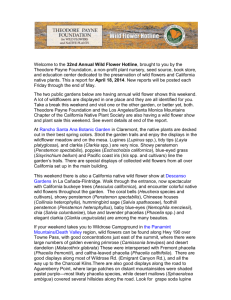doc April 5 - Theodore Payne Foundation
advertisement
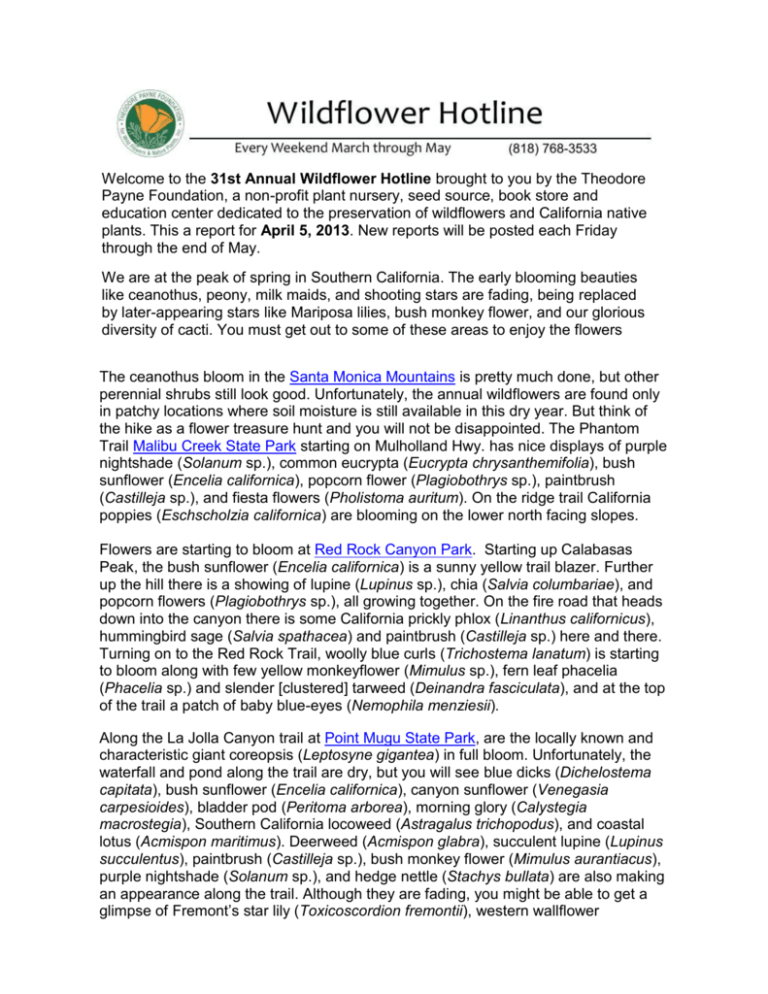
Welcome to the 31st Annual Wildflower Hotline brought to you by the Theodore Payne Foundation, a non-profit plant nursery, seed source, book store and education center dedicated to the preservation of wildflowers and California native plants. This a report for April 5, 2013. New reports will be posted each Friday through the end of May. We are at the peak of spring in Southern California. The early blooming beauties like ceanothus, peony, milk maids, and shooting stars are fading, being replaced by later-appearing stars like Mariposa lilies, bush monkey flower, and our glorious diversity of cacti. You must get out to some of these areas to enjoy the flowers The ceanothus bloom in the Santa Monica Mountains is pretty much done, but other perennial shrubs still look good. Unfortunately, the annual wildflowers are found only in patchy locations where soil moisture is still available in this dry year. But think of the hike as a flower treasure hunt and you will not be disappointed. The Phantom Trail Malibu Creek State Park starting on Mulholland Hwy. has nice displays of purple nightshade (Solanum sp.), common eucrypta (Eucrypta chrysanthemifolia), bush sunflower (Encelia californica), popcorn flower (Plagiobothrys sp.), paintbrush (Castilleja sp.), and fiesta flowers (Pholistoma auritum). On the ridge trail California poppies (Eschscholzia californica) are blooming on the lower north facing slopes. Flowers are starting to bloom at Red Rock Canyon Park. Starting up Calabasas Peak, the bush sunflower (Encelia californica) is a sunny yellow trail blazer. Further up the hill there is a showing of lupine (Lupinus sp.), chia (Salvia columbariae), and popcorn flowers (Plagiobothrys sp.), all growing together. On the fire road that heads down into the canyon there is some California prickly phlox (Linanthus californicus), hummingbird sage (Salvia spathacea) and paintbrush (Castilleja sp.) here and there. Turning on to the Red Rock Trail, woolly blue curls (Trichostema lanatum) is starting to bloom along with few yellow monkeyflower (Mimulus sp.), fern leaf phacelia (Phacelia sp.) and slender [clustered] tarweed (Deinandra fasciculata), and at the top of the trail a patch of baby blue-eyes (Nemophila menziesii). Along the La Jolla Canyon trail at Point Mugu State Park, are the locally known and characteristic giant coreopsis (Leptosyne gigantea) in full bloom. Unfortunately, the waterfall and pond along the trail are dry, but you will see blue dicks (Dichelostema capitata), bush sunflower (Encelia californica), canyon sunflower (Venegasia carpesioides), bladder pod (Peritoma arborea), morning glory (Calystegia macrostegia), Southern California locoweed (Astragalus trichopodus), and coastal lotus (Acmispon maritimus). Deerweed (Acmispon glabra), succulent lupine (Lupinus succulentus), paintbrush (Castilleja sp.), bush monkey flower (Mimulus aurantiacus), purple nightshade (Solanum sp.), and hedge nettle (Stachys bullata) are also making an appearance along the trail. Although they are fading, you might be able to get a glimpse of Fremont’s star lily (Toxicoscordion fremontii), western wallflower (Erysimum capitatum), canyon pea (Lathyrus vestitus), chaparral currant (Ribes malvaceum), and fuchsia-flowered gooseberry (Ribes speciosum). Catalina Mariposa Lily (Calochortus catalinae) & giant coreopsis (Leptosyne gigantea). Photos by Michael Charters The Grotto Trail at Circle X Ranch rewards hikers with some very nice blooms. Fremont’s star lily (Toxicoscordion fremontii) was abundant. Outside the group campground are canyon sunflower (Venegasia carpesioides) and blue dicks (Dichelostema capitata) standing out among the sunflowers. Blue larkspur (Delphinium sp.) and Chinese houses (Collinsia heterophylla) are decorating the rocky seep as you continue up to the meadow, and further along you’ll catch the fragrant aroma of black sage (Salvia mellifera) and woolly blue curls (Trichostema lanatum). Finally reaching the meadow, you will be rewarded with Catalina mariposa lilies (Calochortus catalinae) and blue eyed grass (Sisyrinchium bellum). Chamise (Adenostoma fasciculatum) is experiencing an early bloom as you continue to descend through the chaparral and the pretty virgin’s bower (Clematis sp.) is twining its way through shrubs. Along the trail at the canyon bottom is hedge nettle (Stachys bullata), baby blue eyes (Nemophila menziesii) and hummingbird sage (Salvia spathaceae). Happy Hollow campground was carpeted in dove lupine (Lupinus bicolor), with patches of Johnny-ump-ups (Viola pedunculata), the hillside displays padre shooting stars (Dodecatheon clevelandii). On the Canyon View Trail, look for yellow monkey flower (Mimulus sp.) twining snapdragon (Antirrhinum kelloggii), chia (Salvia columbariae), catepillar phacelia (Phacelia cicutaria), globe gilia (Gilia capitata), and collarless poppies (Eschscholia caespitosa). At Stough Canyon Nature Center in the Verdugo Mountains hike along Stough Canyon or Wildwood Canyon Roads and enjoy the colorful and fragrant, black sage (Salvia mellifera), bush sunflower (Encelia californica), succulent lupine (Lupinus succulentus), golden currant (Ribes aureum) and caterpillar phacelia (Phacelia cicutaria). This is an excellent urban escape for a family outing. Hungry Valley SRVA near Gorman is beginning to display a lot of color. The bluepurple bush lupine (Lupinus sp.) is stunning together with goldenbush (Ericameria sp.). Another colorful couple is the pale yellow bladderpod (Peritoma arborea) and bright red-orange paintbrush (Castilleja sp.). Annuals can be found along the roads in patches and include baby blue-eyes (Nemophila menziesii) fiddlenecks (Amsinckia tessellata), California poppies (Eschscholzia californica) coreopsis (Leptosyne [coreopsis] bigelovii) and Spencer’s primrose (Camissoniopsis [Camissonia] micrantha). New plants are coming into bloom each week, so stay tuned to reports from this area. Hungry Valley State Recreation Area. Photo by Lora Owens Straight north of Hungry Valley and east of Arvin along the Hwy. 223 is a spectacular bloom on the slopes along the highway. Large patches of lupines (Lupinus sp.), California poppies (Eschscholzia californica), purple owl’s clover (Castilleja exerta), white forget-me-nots (Crytantha spp.), white layia (Layia glandulosa) and much more. You must stay on the roads if you are exploring and taking photos in this area. Figueroa Mountain in Santa Barbara County is still spectacular. Early bloomers are still showy and later blooming flowers are just starting. You must get out to see this! The tour up to the mountain starts after crossing the first cattle guard on Figueroa Mountain Road. Under the tree canopy buttercups (Ranunculus sp.), milk maids (Cardamine californica), shooting stars (Dodecatheon sp.), Johnny-jump-ups (Viola pedunculata), wild hyacinth (Dichelostemma capitata), fiesta flower (Pholistoma auritum) and hummingbird sage (Salvia spathaceae) stand out like confetti along the grassy slopes. A little further on the road you will see a slope where sky lupine (Lupinus nanus) is dominant. Continuing up the hill, California poppies (Eschscholzia californica) are opening their golden buds. Look for bright pink prickly phlox (Leptodactylon californicum) on the serpentine slopes. Other wildflowers dotting the landscape include miner’s lettuce (Claytonia sp.), goldfields (Lasthenia gracilis), coreopsis (Leptosyne sp.), miniature lupine (Lupinus bicolor), wild onion (Allium sp.) and wallflowers (Erysimum capitatum). At Vista Point, stop and photograph the beautiful chocolate lilies (Fritillaria biflora) and shooting stars (Dodecatheon sp.) still in bloom. Beyond the station, bush lupine (Lupinus sp.) are starting to explode, both in color and fragrance—a treat for the senses. Wildflowers continue to amaze as you head beyond the station to Lookout Road and the campground. There is a nice display at the Davy Brown Trailhead including phacelias (Phacelia spp.), poppies (Eschscholzia californica) and sky lupine (Lupinus nanus). Happy Canyon, just beyond the campground, you will see the vibrant, red-orange Indian paintbrush (Castilleja sp.) and bush poppy (Dendromecon rigida) adorning the rocky hillside. A little further down the road, yellow coreopsis (Leptosyne sp.), some Mariposa lilies (Calochortus sp.) and bush lupine (Lupinus sp.) are splendid in the landscape. Sky Lupine (Lupinus nanus). Photo by Michael Charters Make sure you visit Descanso Gardens in La Cañada-Flintridge this spring. You will find the natives blooming profusely throughout the garden. The hummingbird sage (Salvia spathacea), coral bells (Heuchera spp.), lilac verbena (Verbena lilacena) and desert mallow (Sphaeralcea ambigua), along with the cheery bush sunflower (Encelia californica) and several sage species (Salvia spp.) are making very fragrant and colorful displays. Annual wildflowers are also found all over and include purple owl’s clover (Castilleja sp. ), five spot (Nemophila maculata), baby-blue-eyes (Nemophila menziesii), tidy tips (Layia platyglossa), chia (Salvia columbariae) and California poppies (Eschscholzia californica ). Check out the rare and beautiful Baja desert rose (Rosa minutiflora) at the Environmental Nature Center in Newport Beach. Its prickly branches are covered with a bright lime green foliage and pretty pink rose blossoms with yellow centers. There is also a “sage extravaganza” going on in the garden with purple sage (Salvia leucophylla), black sage (Salvia mellifera), Munz’s sage (Salvia munzii), and hummingbird sage (Salvia spathacea) in full bloom. Their fragrant cousin, woolly blue curls (Trichostema lanatum) is also in bloom. Enjoy the heady aroma as you stroll along the pathways. Prisk Native Garden in Long Beach (on the grounds of Prisk School) is having its annual Open House on two Sundays in a row for wildflower watching: Sunday, April 7, from 1:00 to 4:00 p.m., and again Sunday, April 14, from 1:00 to 4:00 p.m. Admission free. Donations accepted. Garden is a large, very impressive "schoolyard habitat." This is the most fun you can have on a Sunday afternoon. Students of all educational levels, as well as the community, use and enjoy this garden and now it’s your turn. Visit student favorites, Mojave bluebells (Phacelia campanularia), orange wind poppy (Stylomecon heterophylla), thistle sage (Salvia carduaceae) golden Lindley's blazing star (Mentzelia lindleyi), purple owl's clover (Castilleja exserta), meadowfoam (Limnanthes douglasii), tidy tips (Layia platyglossa), desert penstemon (Penstemon pseudospectabilis), outrageous red Eaton’s penstemon (Penstemon eatonii), woolly blue-curls (Trichostema lanatum), beavertail cactus (Opuntia basilaris), many color forms of apricot mallow (Sphaeralcea ambigua), wild hyacinth (Dichelostemma capitata) and many, many more. Prisk Garden is on Los Arcos Ave. between San Vicente and Albury Sts. in Long Beach. Prisk Native Garden, Long Beach. Photo by Michael Letteriello The gardens at Elizabeth Learning Center in Cudahy continue to amaze visitors. The riotous color explosion includes goldfields (Lasthenia sp.), owls clover (Castilleja sp.), chia (Salvia columbariae), thistle sage (Salvia carduacea), Canterbury bells (Phacelia campanularia), Mojave lupine (Lupinus ordoratus), California poppy (Eschscholzia californica), desert gold poppy (Eschscholzia parishii), apricot mallow (Sphaeralcea ambigua), desert chicory (Rafinesquia neomexicana), desert dandelion (Malacothrix glabrata), and desert brittlebush (Encelia farinosa). The beavertail cactus (Opuntia basilaris) has just begun to flower as well! The central habitat garden has many wildflowers, but the shrubby California wild lilacs (Ceanothus spp.), bush poppies (Dendromecon harfordii) and pink fairy duster (Calliandra eriophylla) are very showy here as well. The garden in front of the family clinic has all the wildflowers listed above as well as stunning prickly poppy (Argemone sp.), woolly blue curls (Trichostema lanatum) and cobwebby thistle sage (Salvia carduaceae). Visitors are welcome to visit the campus and enjoy the flowers from 8:00am to 4:00pm Monday thru Friday. They need a visitor pass from the Main Office. The school is located in Cudahy on Elizabeth Street between Atlantic Blvd and Wilcox Ave. Cream cups (Platystemon californicus). Photo by George Nanoski Torrey Pines State Natural Preserve is still experiencing a nice bloom especially along the Guy Fleming, Razor Point and Yucca Point trails. Coast brittlebush (Encelia californica), paintbrush (Castilleja sp.), bush monkeyflower (Mimulus aurantiacus), yellow sea dahlia (Leptosyne [Coreopsis] maritima), bladderpod (Peritoma arborea) and black sage (Salvia mellifera) frame the colorful annuals hugging the ground— sand verbena (Abronia sp.), jewel flower (Streptanthus sp.), wallflower (Erysimum capitatum), California poppies (Eschscholzia californica), goldfields (Lasthenia sp.), ground pinks (Linanthus dianthiflorus) and blue dicks (Dichelostemma capitatum). There are showy displays of Mojave yucca (Yucca schidigera) as well. Enjoy it among the Torrey Pines! This is a lovely park in our treasure chest of State Parks and Beaches. For stunning pictures of this park, you are invited to view Eva Armi's photo album: TPSR Plants in bloom in late March and April by Eva Armi Bush sunflower (Encelia californica), Torrey Pines State Natural Reserve Photo by Lee Kirchhevel. Wildflowers continue to be good at Harford Springs Preserve in Riverside County, especially along the southern and center trails. The most striking display is the many California bluebells (Phacelia minor) tucked in among the rocks and boulders. California poppies (Eschscholzia californica) are blooming in large patches on several hillsides. Cream cups (Platystemmon californicus) and baby blue-eyes (Nemophila menziesii) make pretty patches of cream and blue within swaths of goldfields (Lasthenia sp.). Ground pinks (Linanthus dianthiflorus) are in the southern part of the park for the first time in several years. Just north of Ida Leona Dr. are chocolate lilies (Fritillaria biflora), Fremont’s star lily (Toxicoscordion fremontii), arroyo lupine (Lupinus succulentus) and the odd looking snakeroot (Sanicula bipinnifitida) poking up along the grassy slopes. The last guided wildflower walk of the season is Saturday, April 6th. Get out there and enjoy it. California bluebells and wildflower patch at Harford Springs Preserve. Photo by Barbara Iyer. Not far from Harford Springs is the MWD Diamond Valley Lake in Hemet. The Wildflower Loop and Lakeview Trails at this popular Inland Empire recreation area are in spectacular bloom. Three phacelias—California bells (Phacelia minor), fern-leaf phacelia (Phacelia distans) and caterpillar phacelia (Phacelia cicutaria) are showy now along with their cousins (in the same family) popcorn flower (Plagiobothrys canescens), forget-me-not (Cryptantha intermedia) and whispering bells (Emmenanthe pendulaflora). Large patches of goldfields (Lasthenia sp.) dot the open south facing hillsides and flat drainages. The goldorange of California poppy (Eschscholzia californica) and pale yellow cream cups (Platystemon californicus) make a nice contrast to the blue and purple and arroyo lupine (Lupinus succulentus) and chia (Salvia columbariae). Blue dicks (Dichelostemma capitatum) stand tall among them along the trails. Chuparosa (Justicia californica), creosote (Larrea tridentata), ocotillo (Fouquieria splendens), and desert brittlebush (Encelia farinosa) aka “the usual suspects” are still blooming in some places along the roadside in Anza-Borrego Desert State Park. In the southern part of the park, many cacti are in full bloom, including the beautiful red flowers of Wolf’s opuntia (Cylindropuntia wolfii), the showy flowers of Engelmann’s hedgehog cactus (Echinocereus engelmannii) and the fuchsiared flowers on the beavertail cactus (Opuntia basilaris). You can see all of these in bloom along S2 in Sweeney Pass and south toward Ocotillo. Look for goldfields (Lasthenia sp.) coming into full bloom at Lake Henshaw. This is the time of year to visit Joshua Tree National Park to see the spectacular Joshua trees (Yucca brevifolia) and Mojave yucca (Yucca schidigera) in bloom especially in the Black Rock area. It has been reported that it is one of the best Joshua tree blooms for many years! You truly need to see this! The large coneshaped, creamy white inflorescences at the tips of Joshua’s extended arms are very showy. Wildflowers throughout most of the park are still sparse, but there are a few wildflower displays in the south end of the park. Hiking in Cottownwood Wash you will encounter white stem blazing star (Mentzelia albicaulis), browneyed primrose, (Chylismia claviformis), forget-me-nots (Cryptantha spp.) and the pretty little desert star (Monoptilon bellioides). Woolly bottle washer (Eremothera boothii), pebble pincushion (Chaenactis carphoclinia) and desert star vine (Brandegea bigelovii) can also be found. Brittle bush (Encelia farinosa), creosote bush (Larrea tridentata), bladderpod (Peritoma arborea) and chuparosa (Justicia californica) are the showy shrubs that can be seen along the road. Just a reminder that east of Joshua Tree on Hwy 177 north of Desert Center check out the sightings of desert lily (Hesperocallis undulata), especially showy in the Desert Lily Preserve Natural Area. Reports from the Bureau of Land Management Office in Needles indicate that there are spectacular flower displays along the highways between I-15 and I-40 and I-95 in the eastern Mojave. Sand vebena (Abronia villosa), dune evening primrose (Oenothera sp.), creosote bush (Larrea tridentata), desert sunflower (Geraea canescens), notch-leaf phacelia (Phacelia crenulata), lupines (Lupinus sp.) and desert encelia (Encelia farinosa) are all visible from the highways. It is especially showy where the bright yellow flowers are contrasted against the black lava flows of the region. Take a little detour along old Route 66 between Needles and Amboy and you will be impressed with the beautiful roadside wildflowers. You must get out and walk around because there are many belly flowers out there that can’t be seen from the car. The Mojave yucca are producing impressive displays in the area as well. Along old Route 66 from U.S. 95 to Fenner the roadside has exploded with desert dandelion (Malacothrix glabrata). U.S. 95 south from Needles to Vidal Junction has nice displays of desert dune primrose (Oenothera sp.), desert dandelion (Malacothrix glabrata), Mojave pincushion (Chaenactis sp.), and a few very nice prickly poppy (Argenome corymbosa) in Lubick Pass. Turtle Mountain Road 23 miles south of Needles on US 95, beaver tail cacti (Opuntia basilaris) are in full bloom and the fishhook cacti (Mammalaria sp.) are just going wild! A note of caution: the bloom has brought out the tortoise in great numbers. Please use caution when driving these areas to avoid harming this threatened species. Fishhook cactus protected by a creosote bush. Photo by Murl Shaver, BLM Needles Office Death Valley National Park has experienced an abnormally dry winter and spring. There's not much in bloom with a couple of exceptions. A couple of weeks ago we mentioned flowers in bloom around Jubilee Pass— Arizona lupine (Lupinus arizonicus), small flowered poppy (Eschscholzia minutiflora), desert sunflower (Geraea canescens), Panamint forget-me-not (Cryptantha angustifolia), and evening primroses (Chylisma claviformis and Chylismia brevipes). Add to that the very photo worthy desert fivespot (Eremalche rotundiflora). One area in the Park that is readily accessible to most visitors is a stretch of Furnace Creek Wash along Hwy 190 extending for about five miles east of the intersection of the road to Dante's View. The wash and its adjacent banks are full of gravel ghost (Atrichoseris platyphylla), Emory rock daisy (Perityle emoryi), golden evening primrose (Chylismia [Camissonia] brevipes), shredding evening primrose (Eremothera [Camissonia] boothii subsp. condensata), notchleaf phacelia (Phacelia crenulata), broad-flowered gilia (Gilia latiflora), small-flowered poppy (Eschscholzia minutiflora), desert gold poppy (Eschscholzia glyptosperma), desert sunflower (Geraea canescens), pebble pincushion (Chaenactis carphoclinia), Fremont Pincushion (Chaenactis fremontii), scented cryptantha (Cryptantha utahensis), lesser mohavea (Mohavea breviflora) and desert trumpet (Eriogonum inflatum). In Greenwater Canyon off the Greenwater Valley Road, there are good displays of the flowers mentioned above in addition to goldfields (Lasthenia californica), desert dandelion (Malacothrix glabrata), desert chicory (Rafinesquia neomexicana), desert tobacco (Nicotiana obtusifolia) and Bigelow's monkeyflower (Mimulus bigelovii). Note that Greenwater Canyon is for a dedicated hiker, probably not a casual visitor. That’s it for this week. Look for our next report on Friday, April 12 and check back each week for the most up to date information on southern and central California wildflowers. If you would like to be a wildflower reporter send your information about wildflower blooms and their location to flowerhotline@theodorepayne.org by Wednesday of each week when blooms of note occur. NATIVE PLANT & WILDFLOWER EVENTS: Theodore Payne Foundation 10th Annual Native Plant Garden Tour, Saturday and Sunday, April 6 & 7 from 10 am – 5 pm. For more information and tickets, visit our webpage. Saturday, April 20: Native Plant Week Symposium, Wildflower Show & Plant Sale. For more information visit our webpage. Huntington Library When They Were Wild: Recapturing California’s Wildflower Heritage March 9 – June 10, 2013 Mary Lou and George Boone Gallery A collaborative project of The Huntington, Rancho Santa Ana Botanic Garden, and the Theodore Payne Foundation for Wildflowers and Native Plants. For more information, go to The Huntington Prisk Native Garden, Long Beach Annual Open House and Wildflower Viewing Two Sundays—April 7, 1:00 – 4:00 pm; and Sunday, April 14, 1:00 – 4:00pm. Admission free. Prisk Garden is on Los Arcos Ave. between San Vicente and Albury Sts. in Long Beach. From the 405 Fwy, take the Palo Verde exit in Long Beach. For more info: 562-481-5216, or letteriello@charter.net. Rancho Santa Ana Botanic Garden Garden Tours Weekends, March 23 through June 9, 1 p.m. Guided walking tours with Garden nature interpreters featuring beautiful California wildflowers and seasonal highlights. Free with standard Garden admission. California Native Plant Society Chapters CNPS-San Diego Chapter April 6 - Public Plant Hike - Saturday Manchester Trails More information April 7 - Field Trip - Sunday Upper Cedar Creek - with Cindy Buxton Everyone welcome More information April 7 - Plant Walk - Sunday Tecolote Nature Center 9:00am to noon More information CNPS – Orange County Chapter Field Trip: April 14, Sunday. 8:00 am. Laguna Coast Wilderness. Go to OCCNPS Field Trips for more information about meeting location, parking fee and hike details. Harford Springs Preserve April 6. 9:00 am – 12:30 pm $2/person Wildlflower walks are being offered through Hidden Valley Nature CenterReservations required. Call 951.785-7452. Parking is at the entrance on Gavilan Road. Southern California Botanists April 7. Wildflower Walk on the Pebble Plains Preserve, Big Bear/Baldwin Lake area. info on socalbot.org
